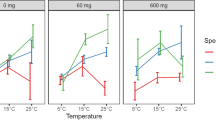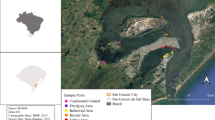Abstract
Numerous wetlands and streams have been impacted by acid mine drainage (AMD) resulting in lowered pH and increased levels of toxic heavy metals. Remediation of these contaminated sites requires knowledge on the response of microbial communities (especially epiphytic) and aquatic plants to these altered environmental conditions. We examined the effect of coal pile runoff waters as an example of AMD in contrast to natural water from Carolina Bays with low pH and levels of metals on Salvinia minima, a non-native, metal accumulating plant and associated epiphytic bacteria. Treatments included water from two Carolina Bays, one AMD basin and Hoagland’s Solution at two pH levels (natural and adjusted to 5.0–5.5). Using controlled replicated microcosms (N = 64) we determined that the combination of low pH and high metal concentrations has a significant negative impact (p < 0.05) on plant condition and epiphytes. Solution metal concentrations dropped indicating removal from solution by S. minima in all microcosms.


Similar content being viewed by others
References
Baker BJ, Banfield JF (2003) Microbial communities in acid mine drainage. FEMS Microbiol Ecol 44:139–152
Brofft JE, McArthur JV, Shimkets LJ (2002) Recovery of novel bacterial diversity from a forested wetland impacted by reject coal. Environ Microbiol 4:764–769
Buta E, Torok A, Csog A, Zongo B, Cantor M, Buta M, Majdik C (2014) Comparative studies of the phytoextraction capacity of five aquatic plants in heavy metal contaminated water. Not Bot Horti Agrobo 42:173–179
Collins B, McArthur JV, Sharitz RR (2004) Plant effects on microbial assemblages and remediation of acidic coal pile runoff in mesocosm treatment wetlands. Ecol Eng 23:107–115
Collins BS, Sharitz RR, Coughlin DP (2005) Elemental composition of native wetland plants in constructed mesocosm treatment wetlands. Bioresour Technol 96:937–948
Curran KJ, Irvine KN, Droppo IG, Murphy TP (2000) Suspended solids, trace metal and PAH concentrations and loadings from coal pile runoff to Hamilton Harbour, Ontario. J Great Lake Res 26:18–30
Davis EC, Boegly WJ (1981) A review of water-quality issues associated with coal storage. J Environ Qual 10:127–133
DeNicola DM, Stapleton MG (2002) Impact of acid mine drainage on benthic communities in streams: the relative roles of substratum vs. aqueous effects. Environ Pollut 119:303–315
Dhir B, Srivastava S (2011) Heavy metal removal from a multi-metal solution and wastewater by Salvinia natans. Ecol Eng 37:893–896
Dhir B, Srivastava S (2013) Heavy metal tolerance in metal hyperaccumulator plant, Salvinia natans. Bull Environ Contam Toxicol 90:720–724
Fry JC, Goulder R, Rimes CA (1985) A note on the efficiency of stomaching for the quantitative removal of epiphytic bacteria from submerged aquatic plants. J Appl Bacteriol 58:113–115
Garland JL, Mills AL (1994) A community-level physiological approach for studying microbial communities. In: Ritz K, Dighton J, Giller KE (eds) Beyond the biomass. British Society of Soil Science, Bedford, pp 77–83
Hoagland DR, Arnon DI (1950) The water culture method of growing plants without soil. Calif Agric Exp Stn Circ 347:36–39
Hobbie JE, Daley RJ, Jasper S (1977) Use of nuclepore filters for counting bacteria by flourescence microscopy. Appl Environ Microb 33:1225–1228
Ledin M, Pedersen K (1996) The environmental impact of mine wastes—roles of microorganisms and their significance in treatment of mine wastes. Earth Sci Rev 41:67–108
McArthur JV (2001) Bacteria as biomonitors. In: Rader RB, Batzer DP, Wissinger SA (eds) Bioassessment and management of North American freshwater wetlands. Wiley, New York, pp 249–261
Merkley M, Rader RB, McArthur JV, Eggett D (2004) Bacteria as bioindicators in wetlands: bioassessment in the Bonneville Basin of Utah, USA. Wetlands 24:600–607
Neter J, Kutner MH, Nachtsheim CJ, Wasserman W (1996) Applied linear statistical models. McGraw-Hill, Boston
Ornes WH, Sajwan KS, Dosskey MG, Adriano DC (1991) Bioaccumulation of selenium by floating aquatic plants. Water Air Soil Pollut 57:53–57
Patrick FM, Loutit MW (1977) The uptake of heavy metals by epiphytic bacteria on Alisma Plantago-Aquatica. Water Res 11:699–703
Rencher AC (1995) Methods of multivariate analysis. Wiley, New York
Schalles JF, Sharitz RR, Gibbons JW, Leversee GJ, Knox JN (1989) Carolina Bays of the Savannah River Plant. National Environmental Research Park Publication SRO-NERP-18, Savannah River Ecology Laboratory, Aiken
Sheoran AS, Sheoran V (2006) Heavy metal removal mechanism of acid mine drainage in wetlands: a critical review. Miner Eng 19:105–116
Tutu H, McCarthy TS, Cukrowsja E (2008) The chemical characteristics of acid mine drainage with particular reference to sources, distribution and remediation: the Witwatersrand Basin, South Africa as a case study. Appl Geochem 23:3666–3694
Wetzel GR, Likens LE (1991) Limnological analysis. W.B. Saunders Company, Philadelphia
Acknowledgments
Financial support was provided from the U.S. Department of Energy Financial Assistance Award no. DE-FC09-96SR18546 to the University of Georgia Research Foundation.
Author information
Authors and Affiliations
Corresponding author
Rights and permissions
About this article
Cite this article
Lindell, A.H., Tuckfield, R.C. & McArthur, J.V. Differences in the Effect of Coal Pile Runoff (Low pH, High Metal Concentrations) Versus Natural Carolina Bay Water (Low pH, Low Metal Concentrations) on Plant Condition and Associated Bacterial Epiphytes of Salvinia minima . Bull Environ Contam Toxicol 96, 602–607 (2016). https://doi.org/10.1007/s00128-016-1756-0
Received:
Accepted:
Published:
Issue Date:
DOI: https://doi.org/10.1007/s00128-016-1756-0




